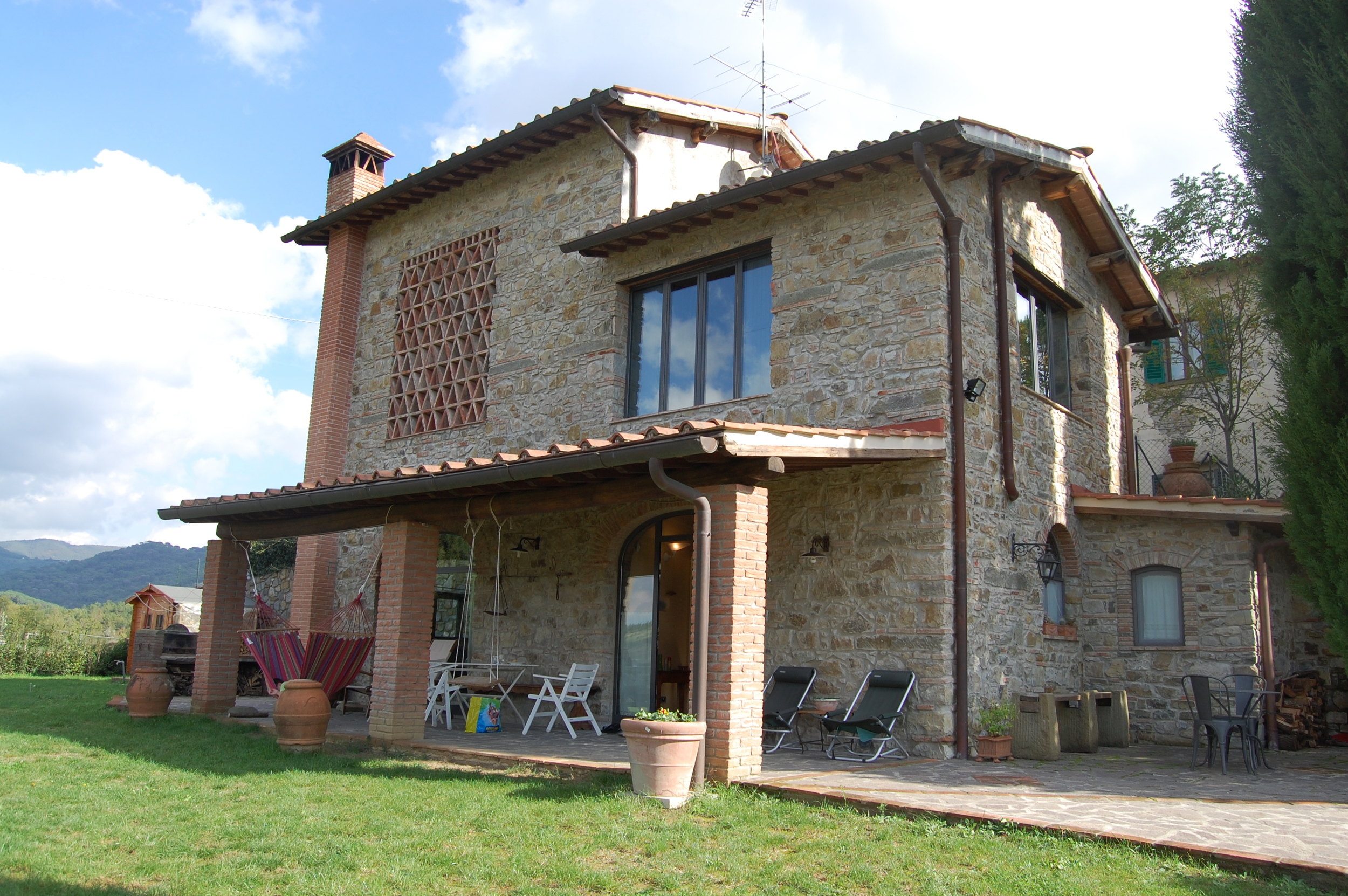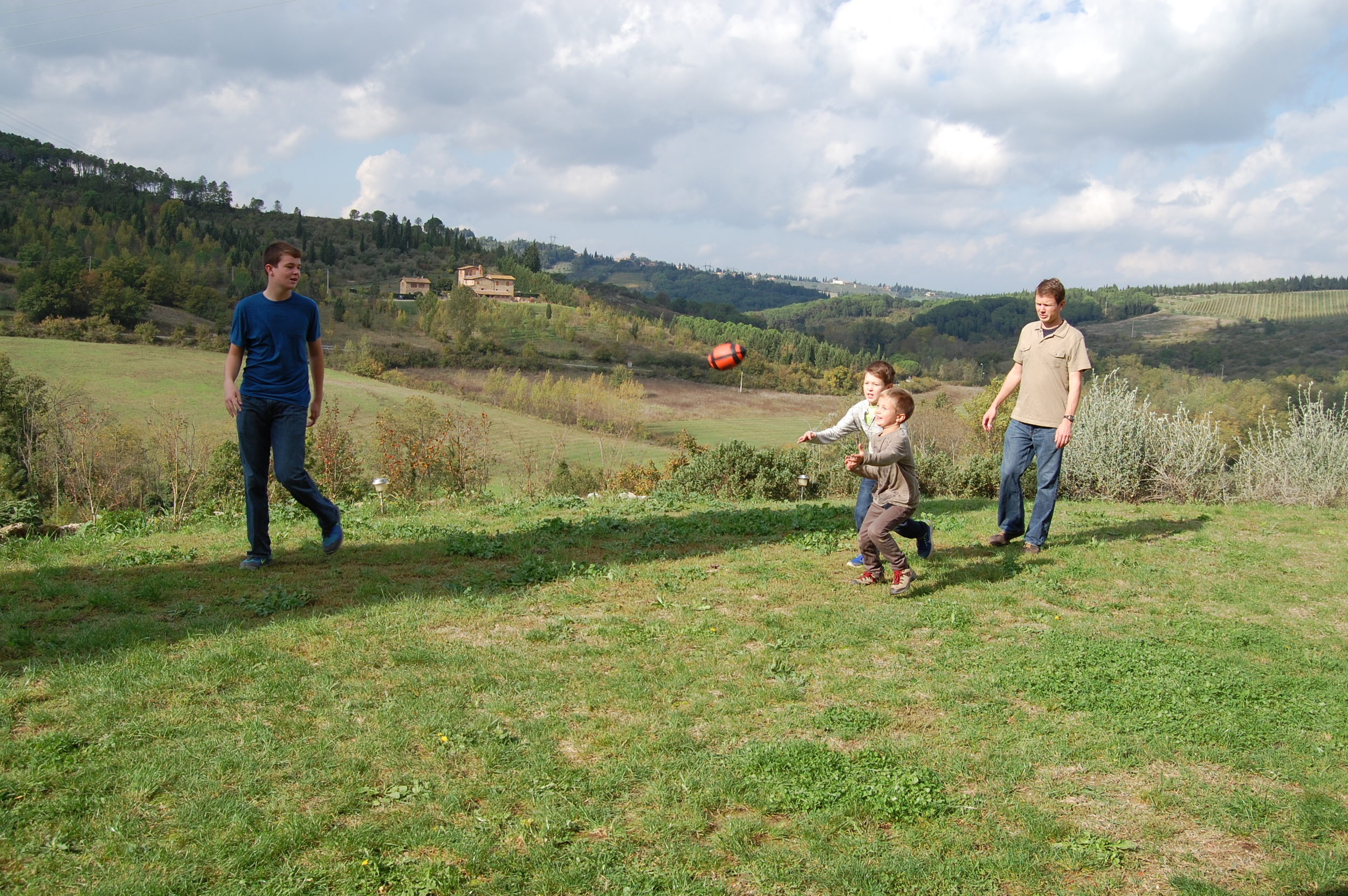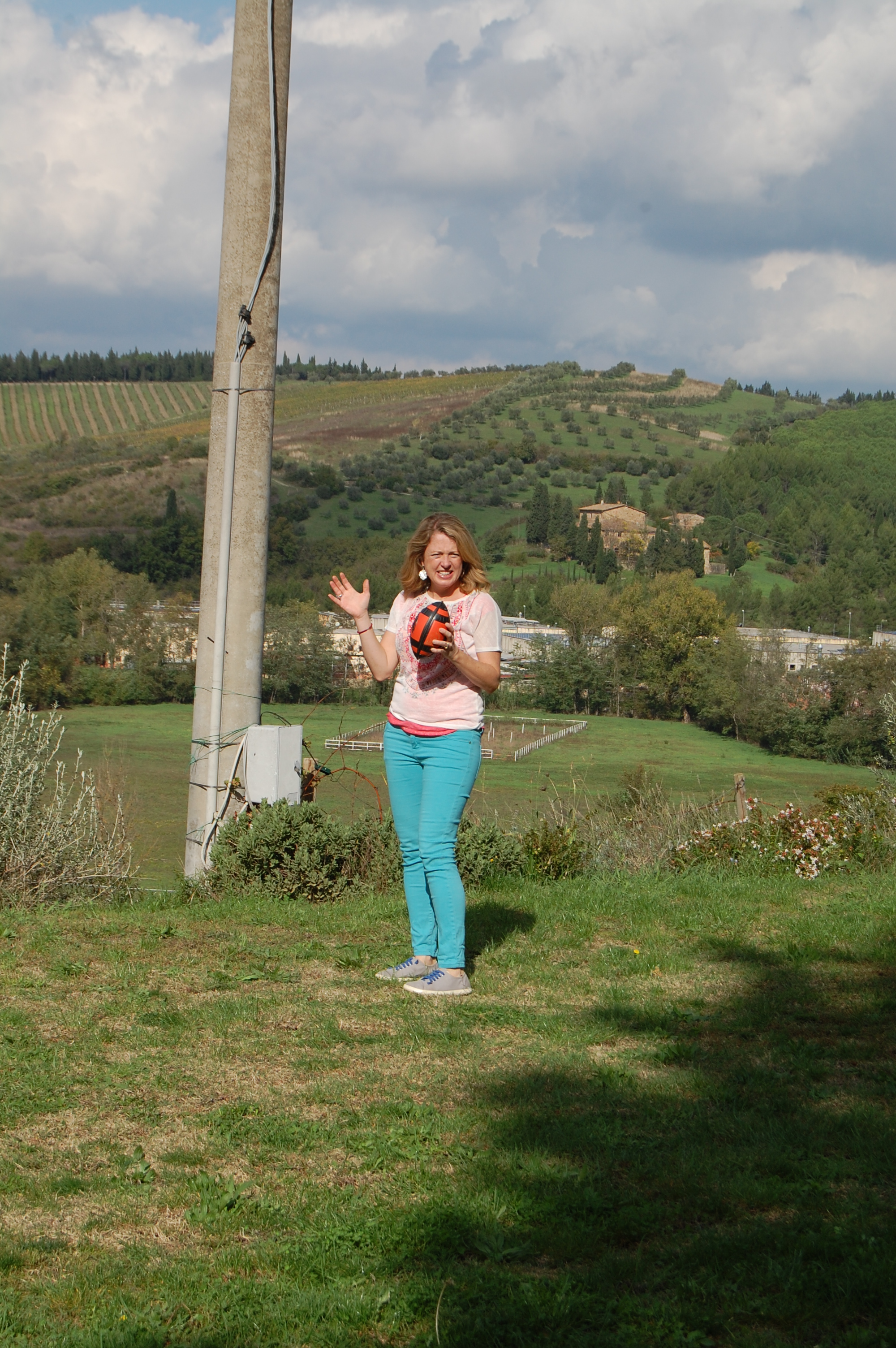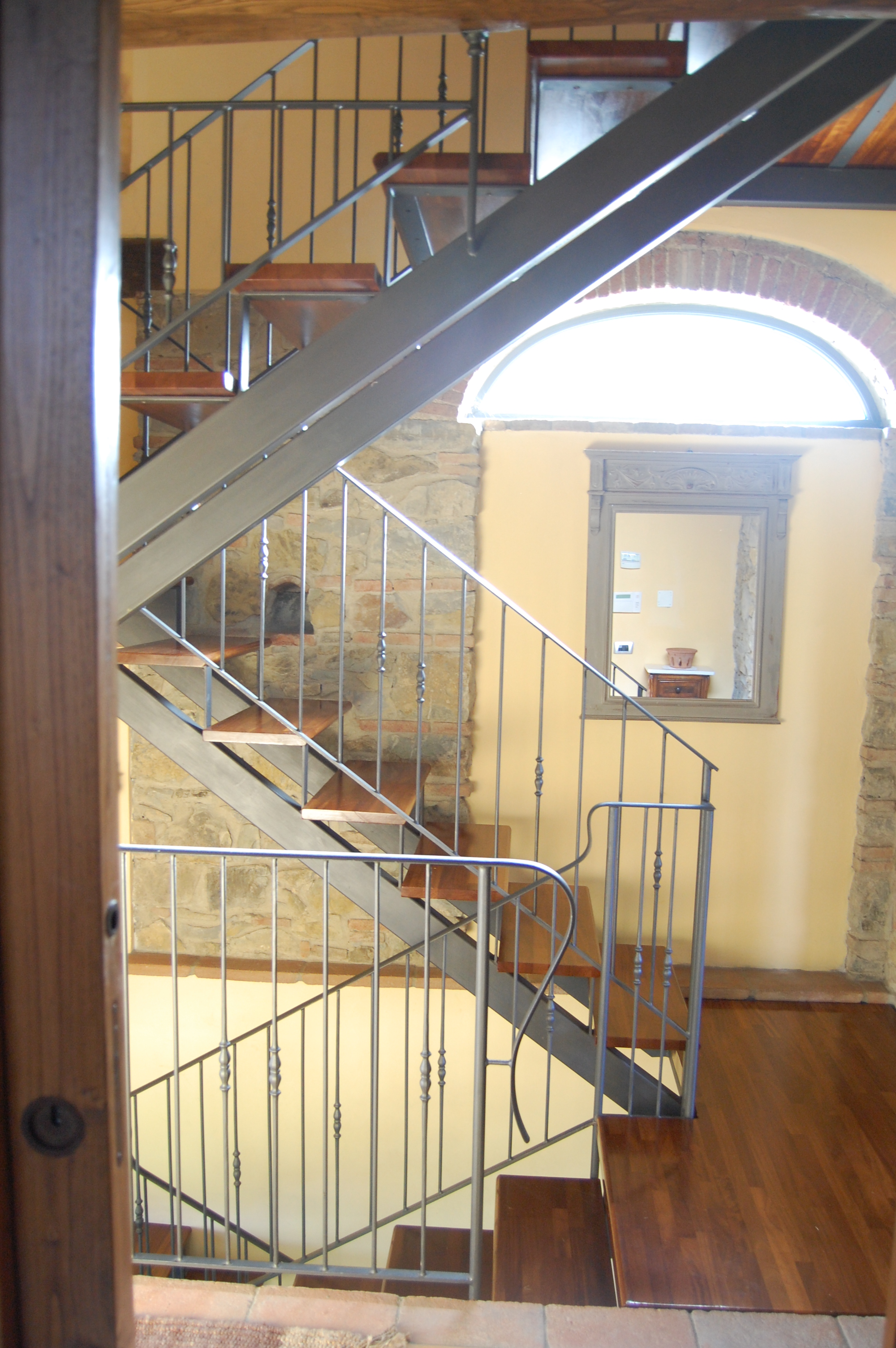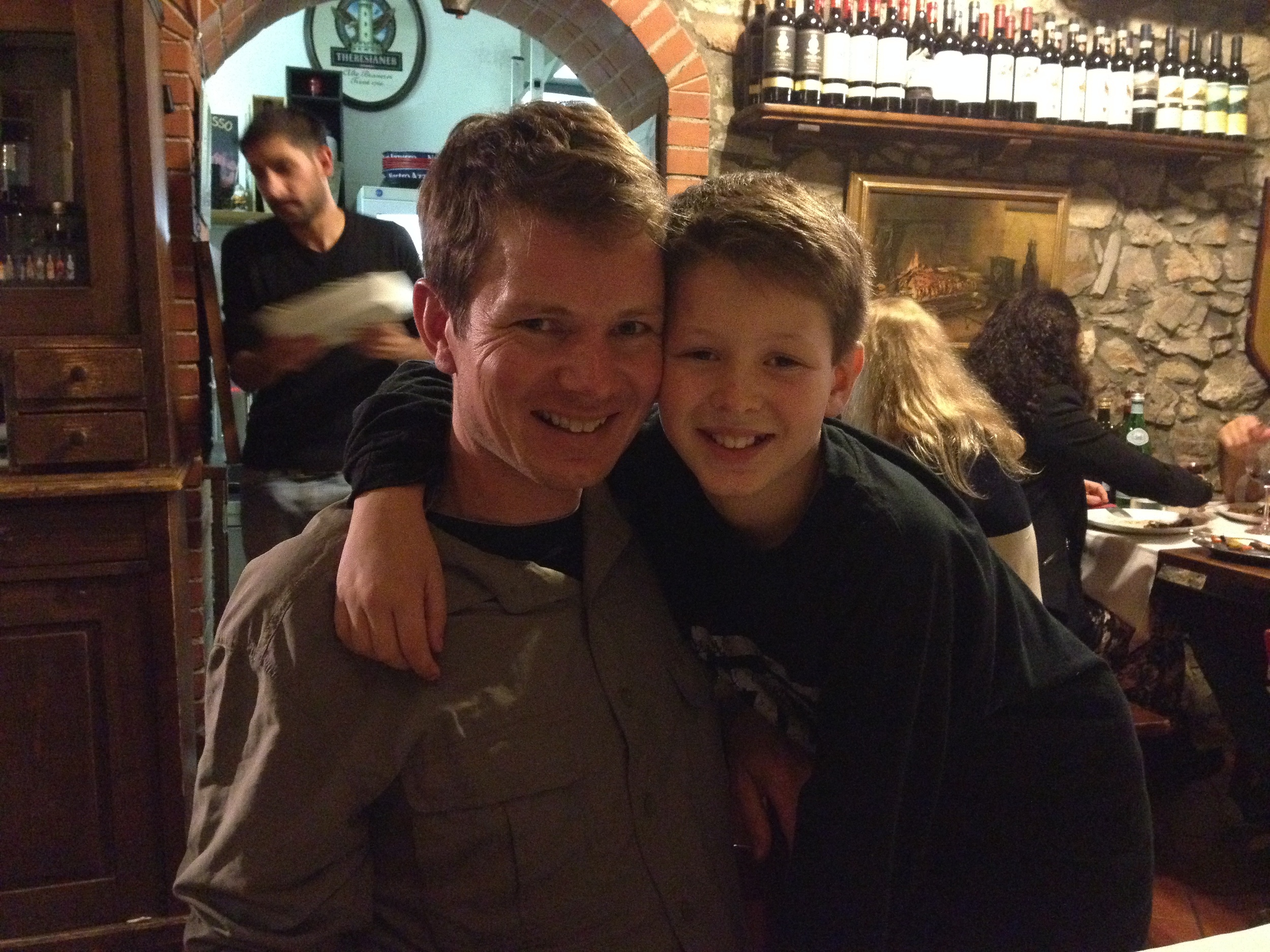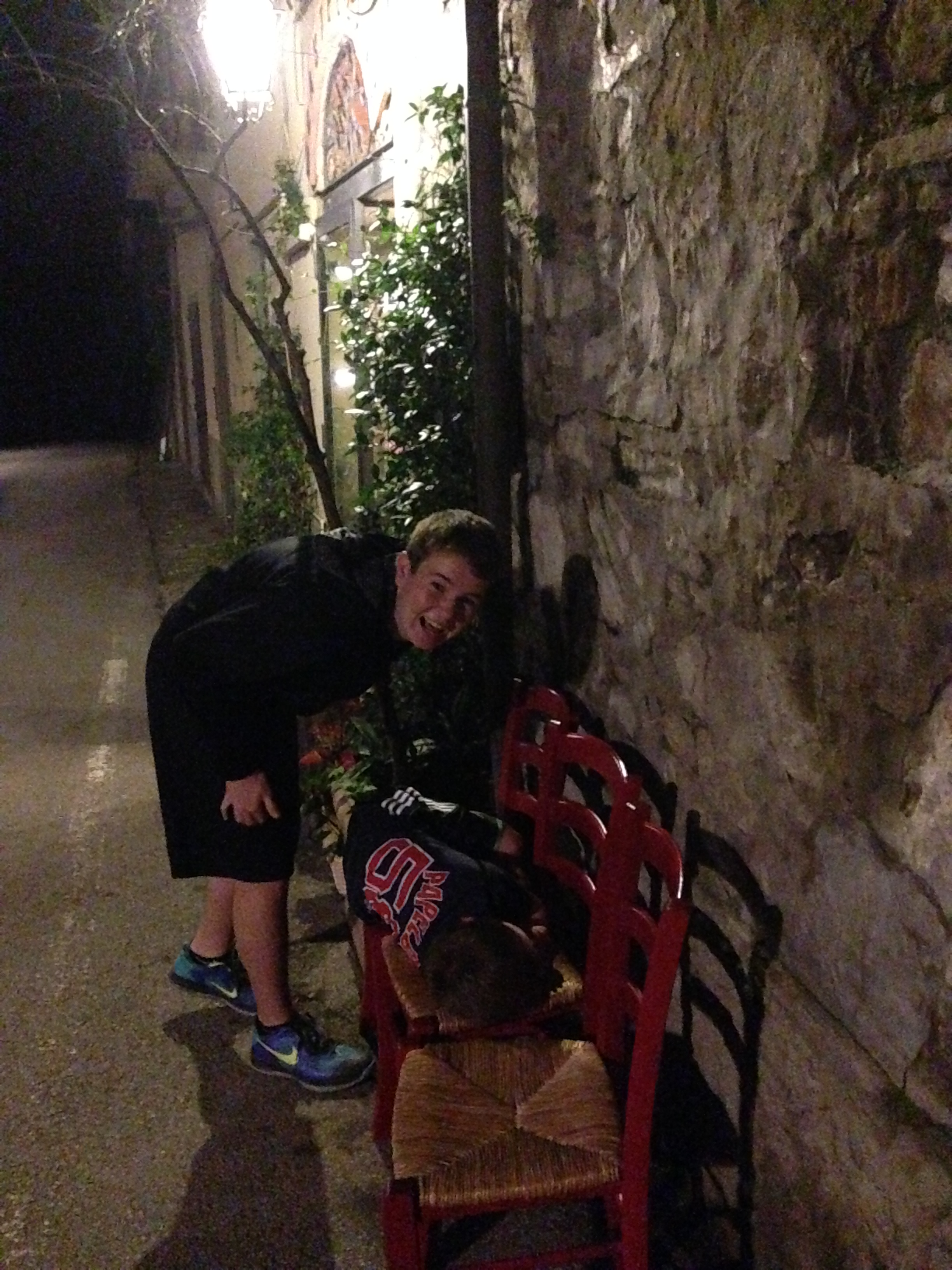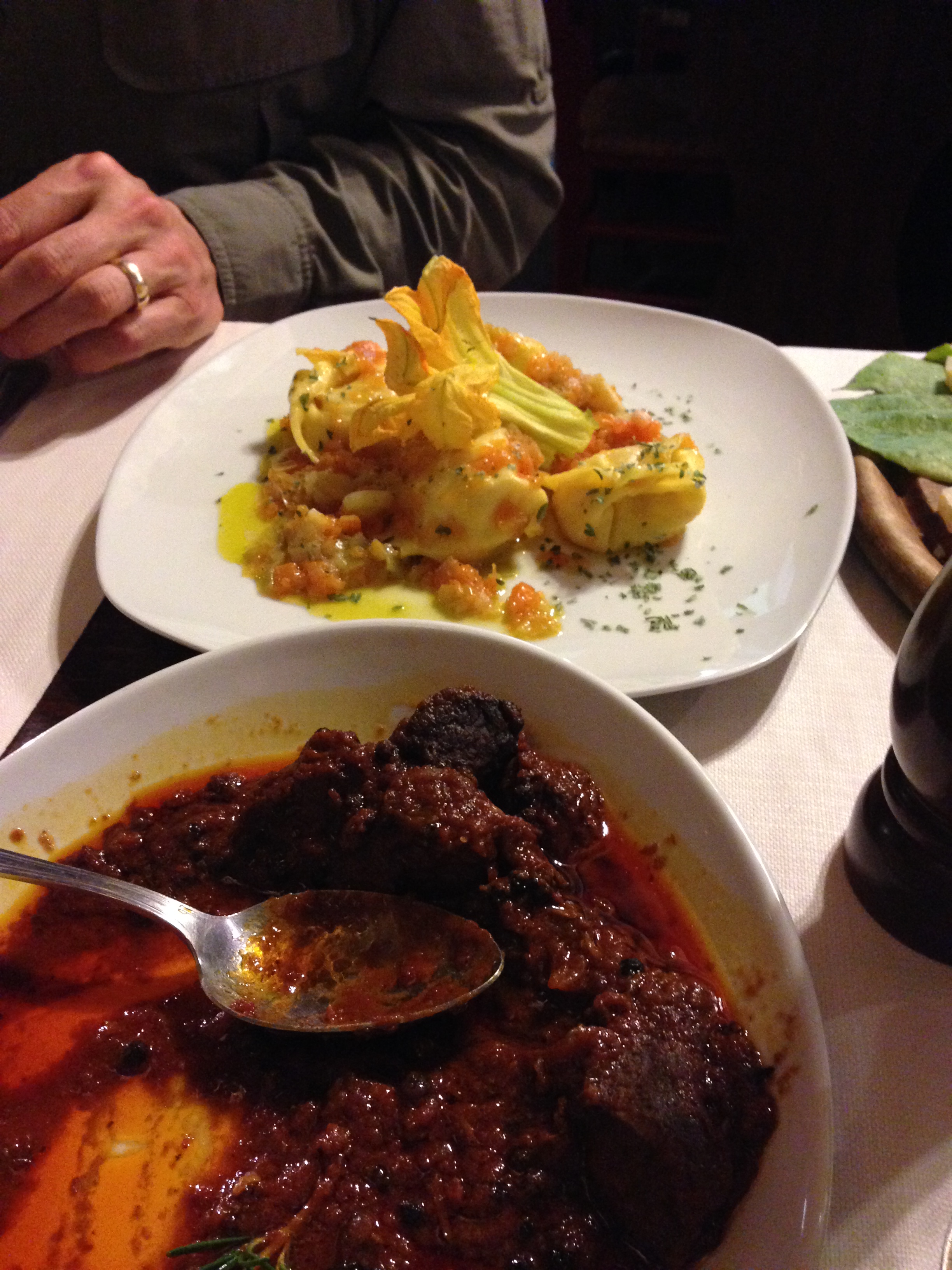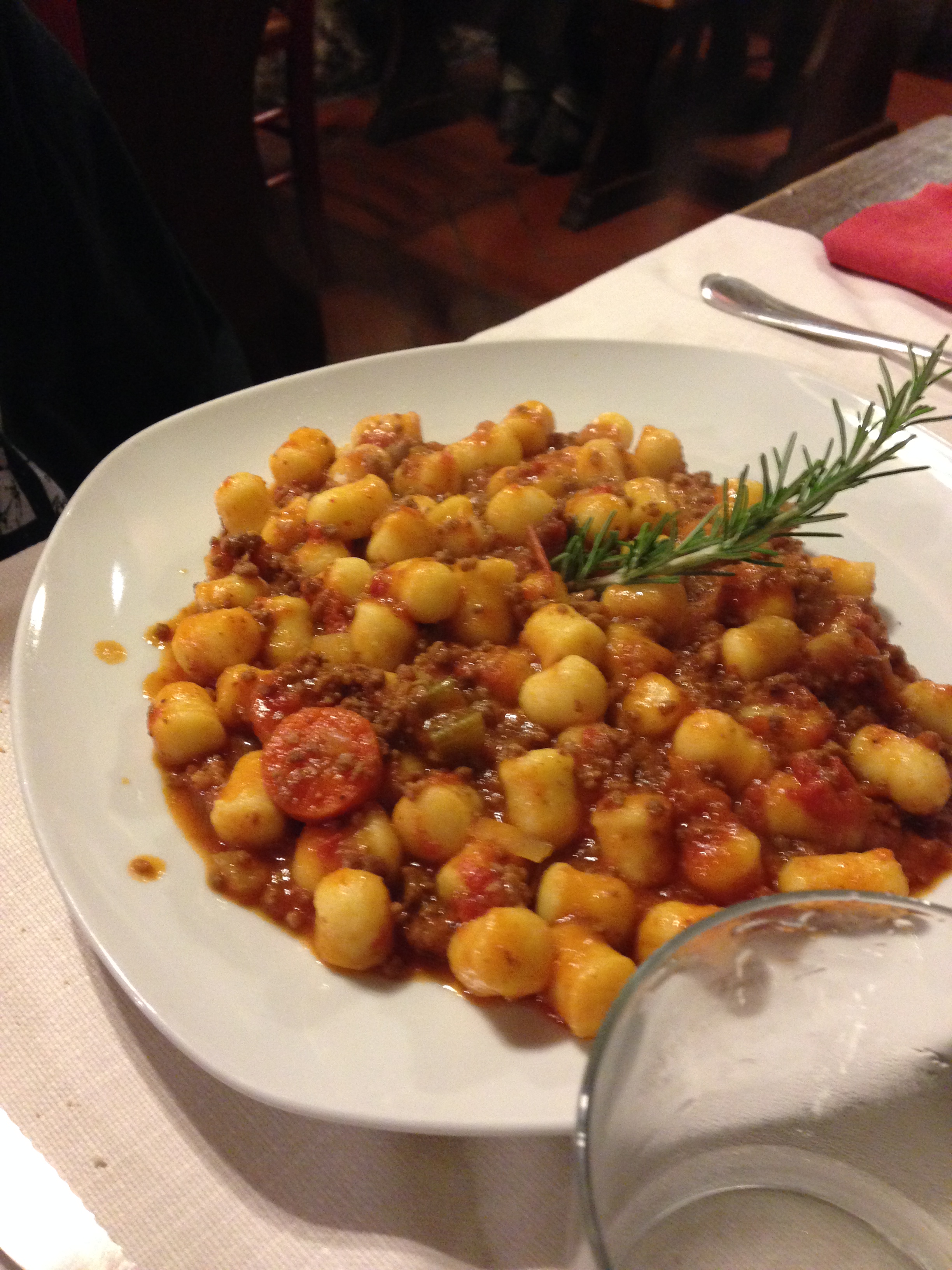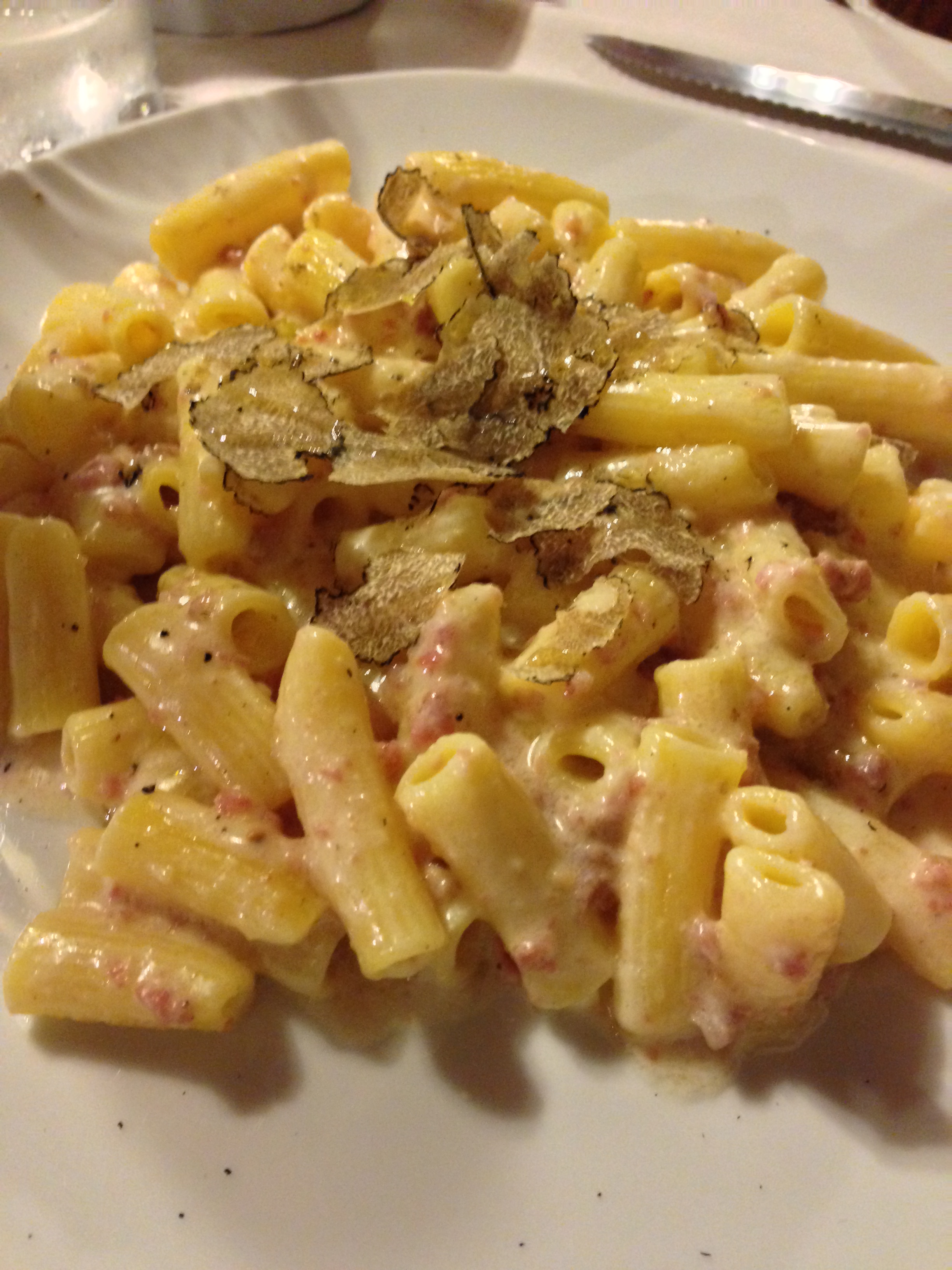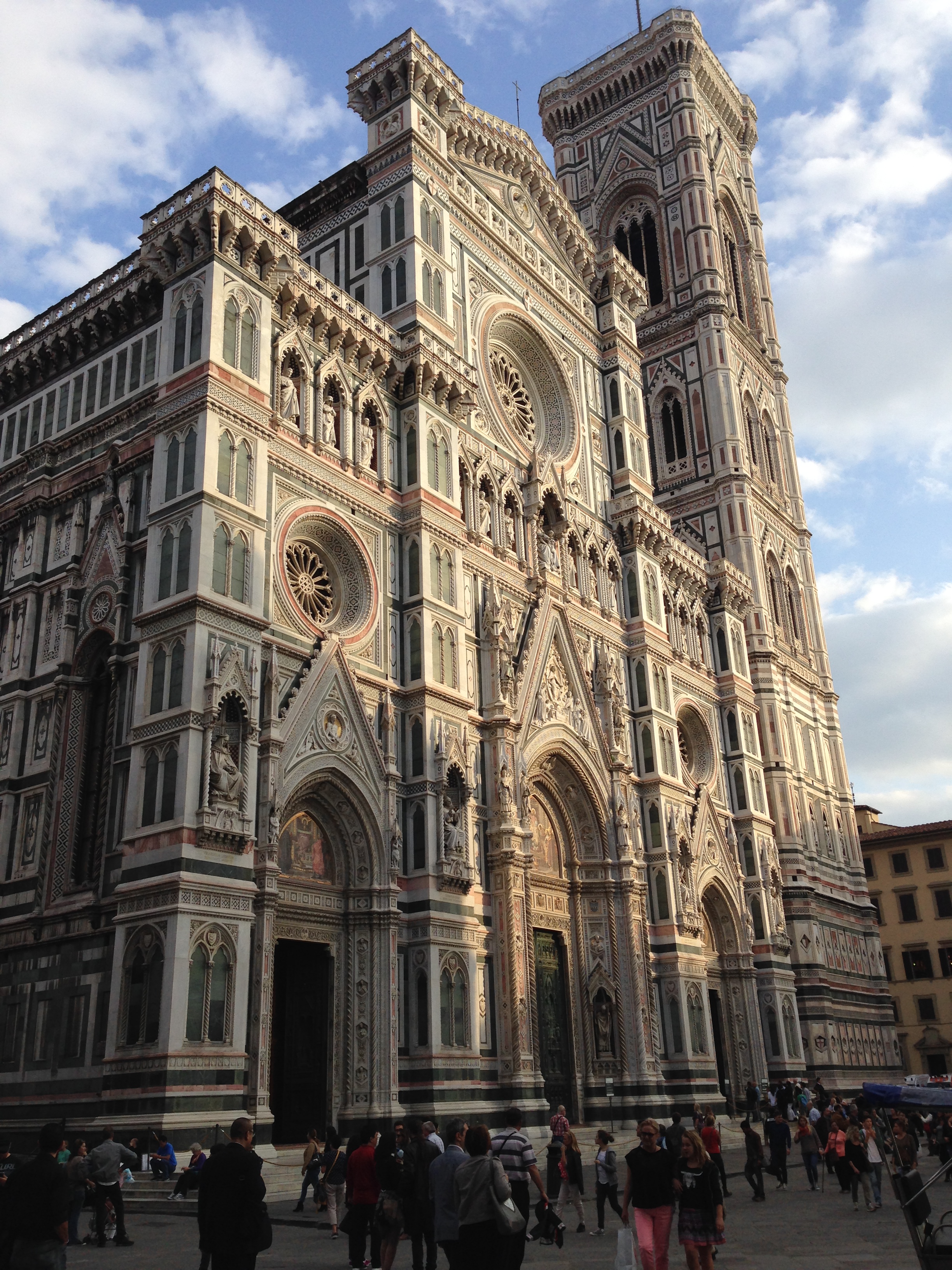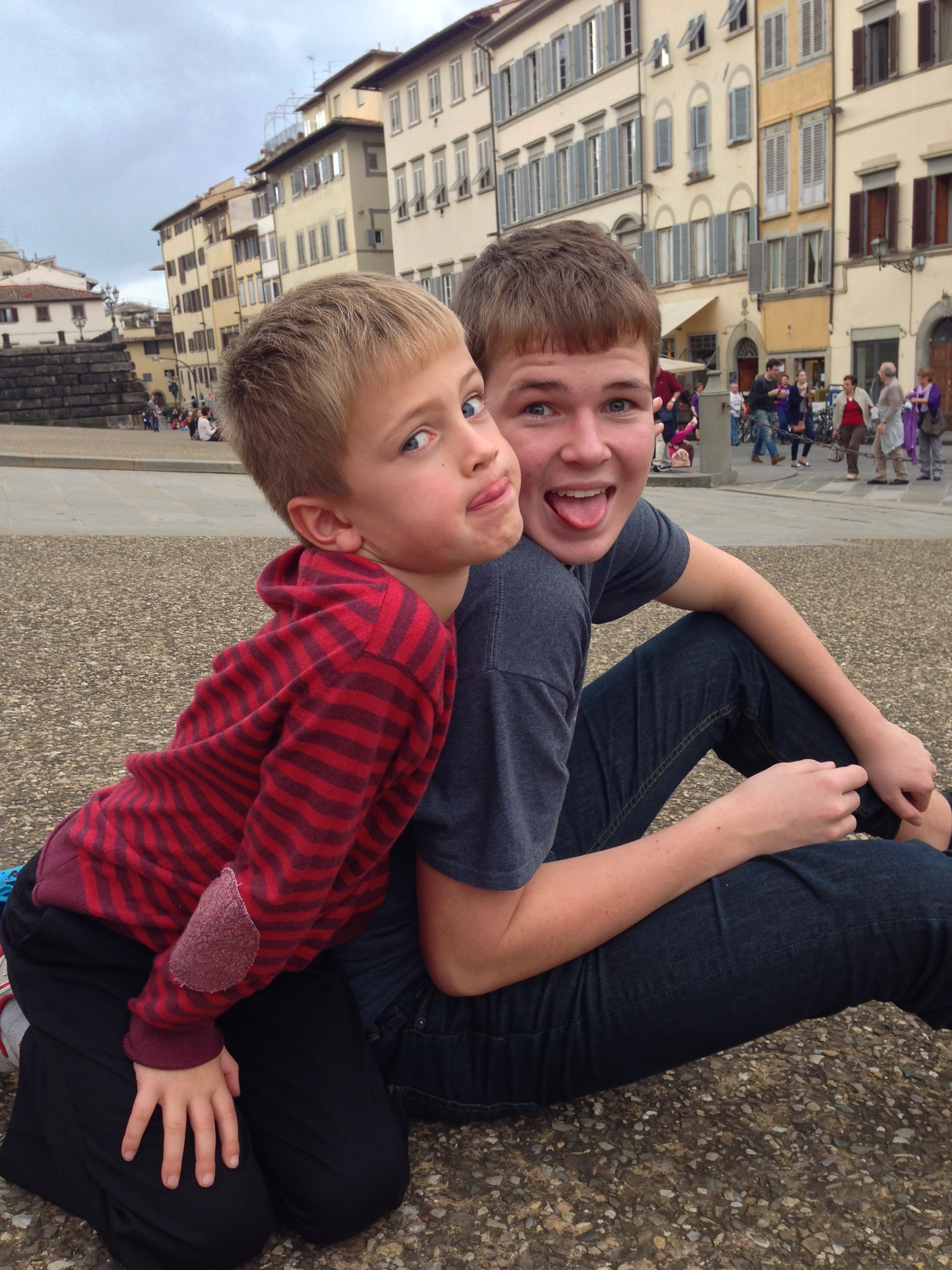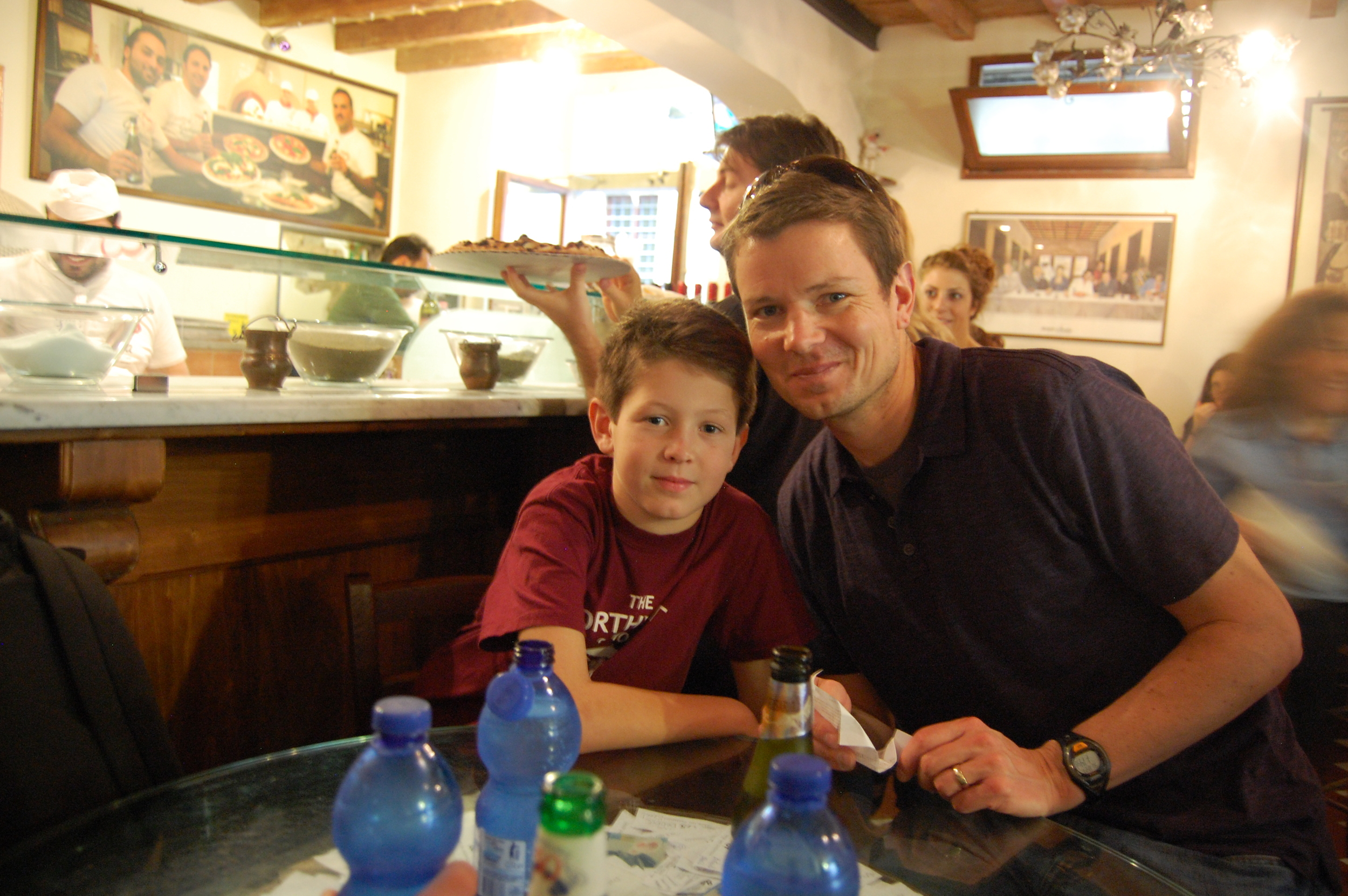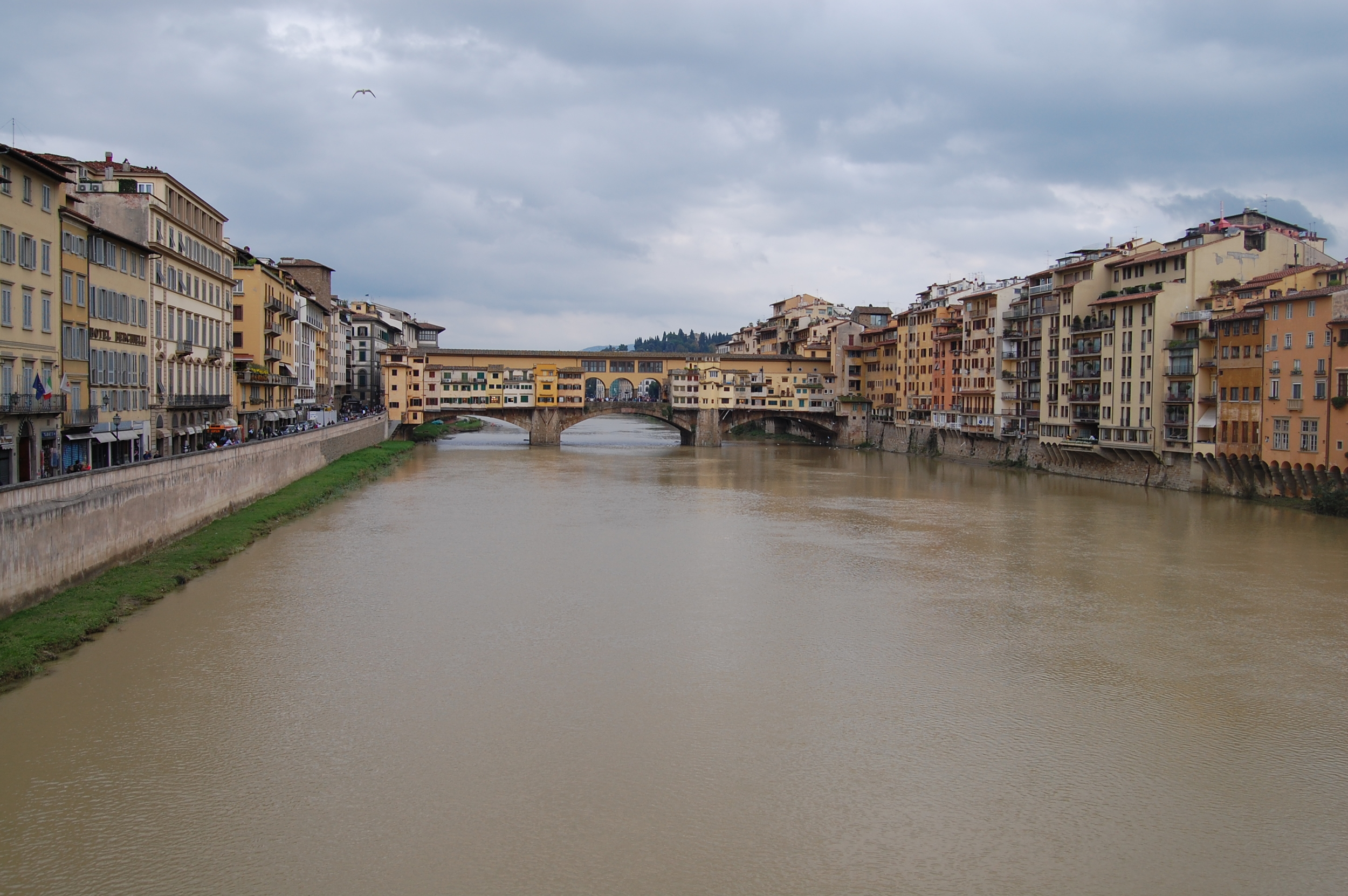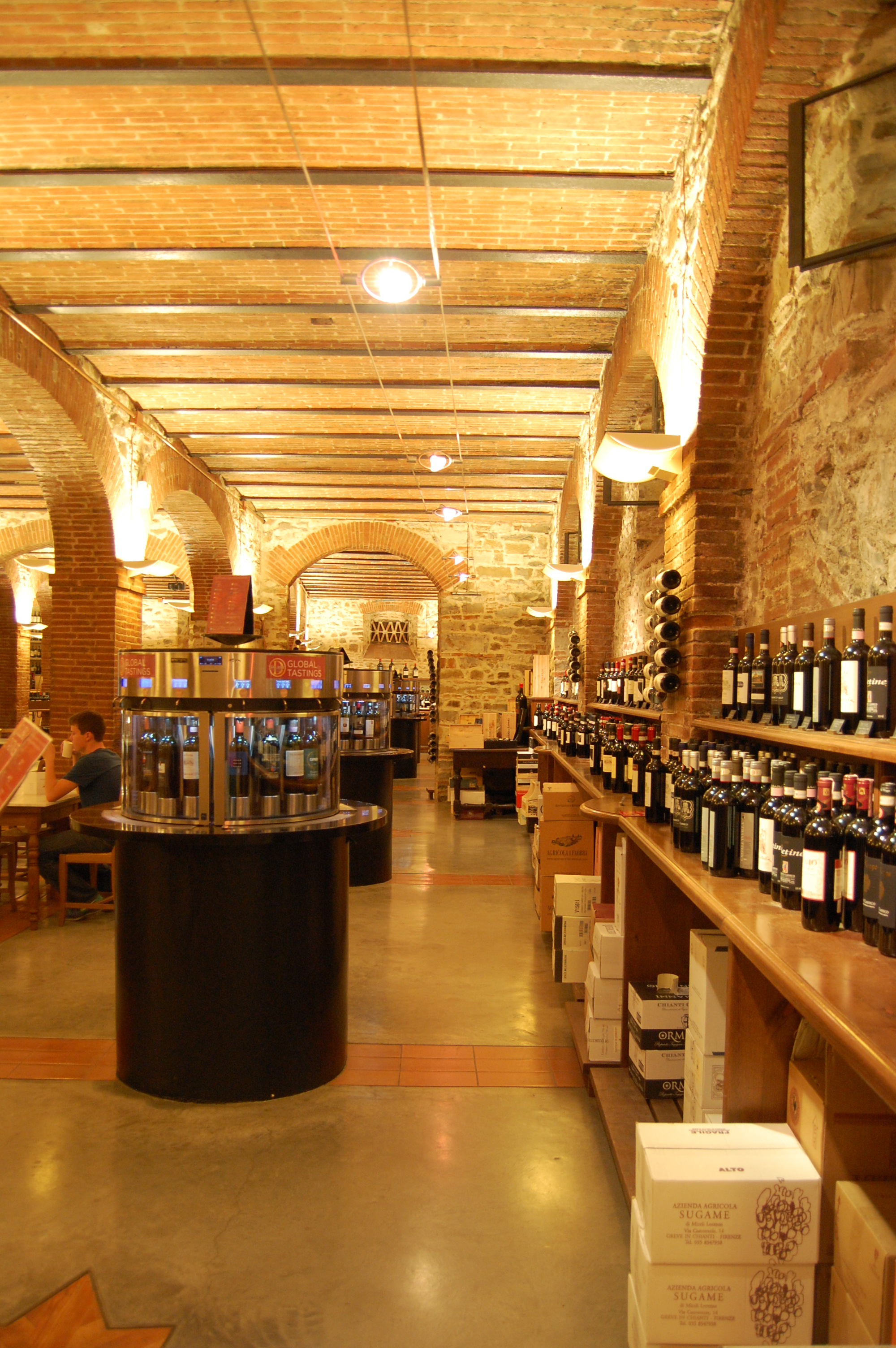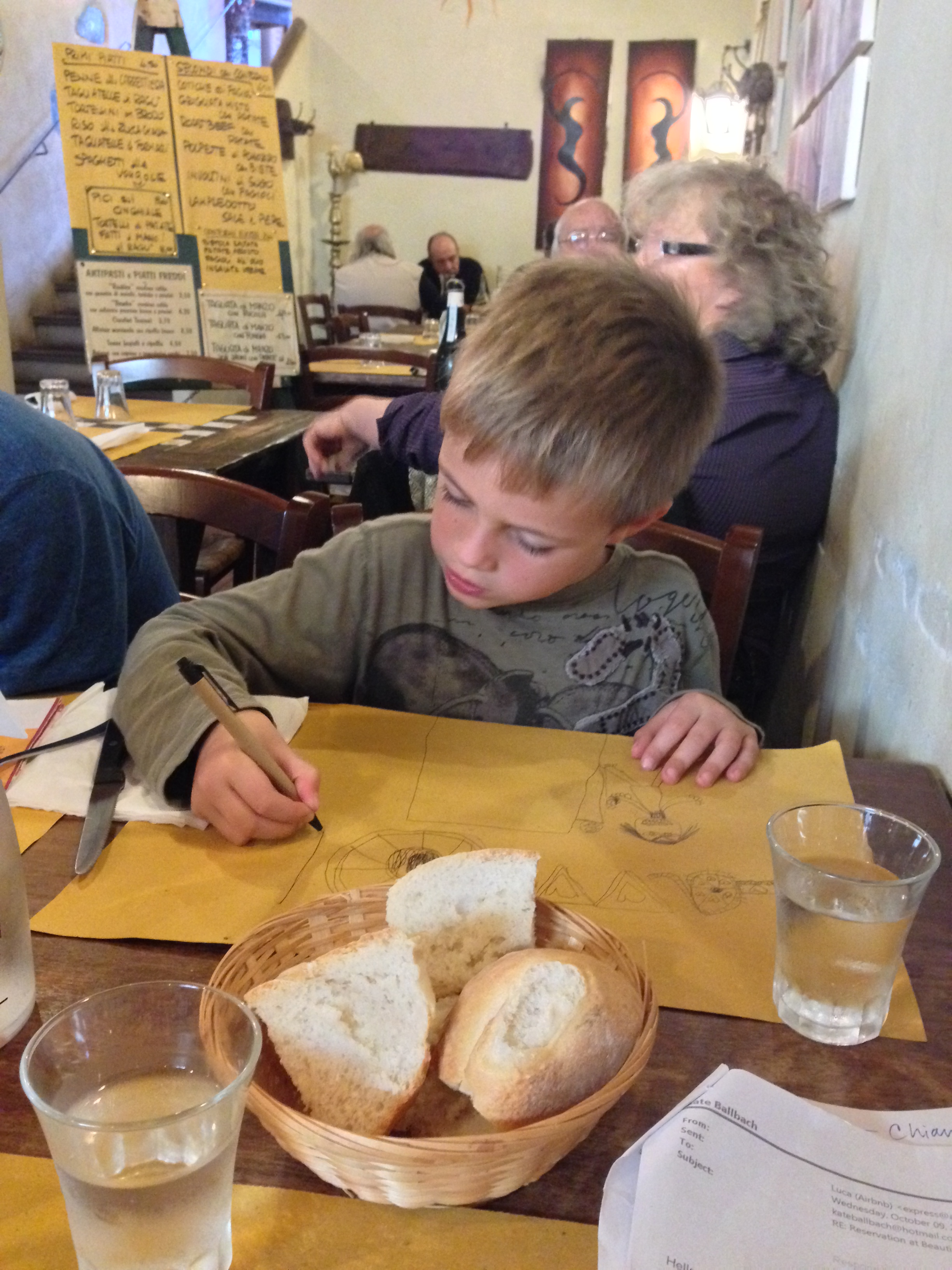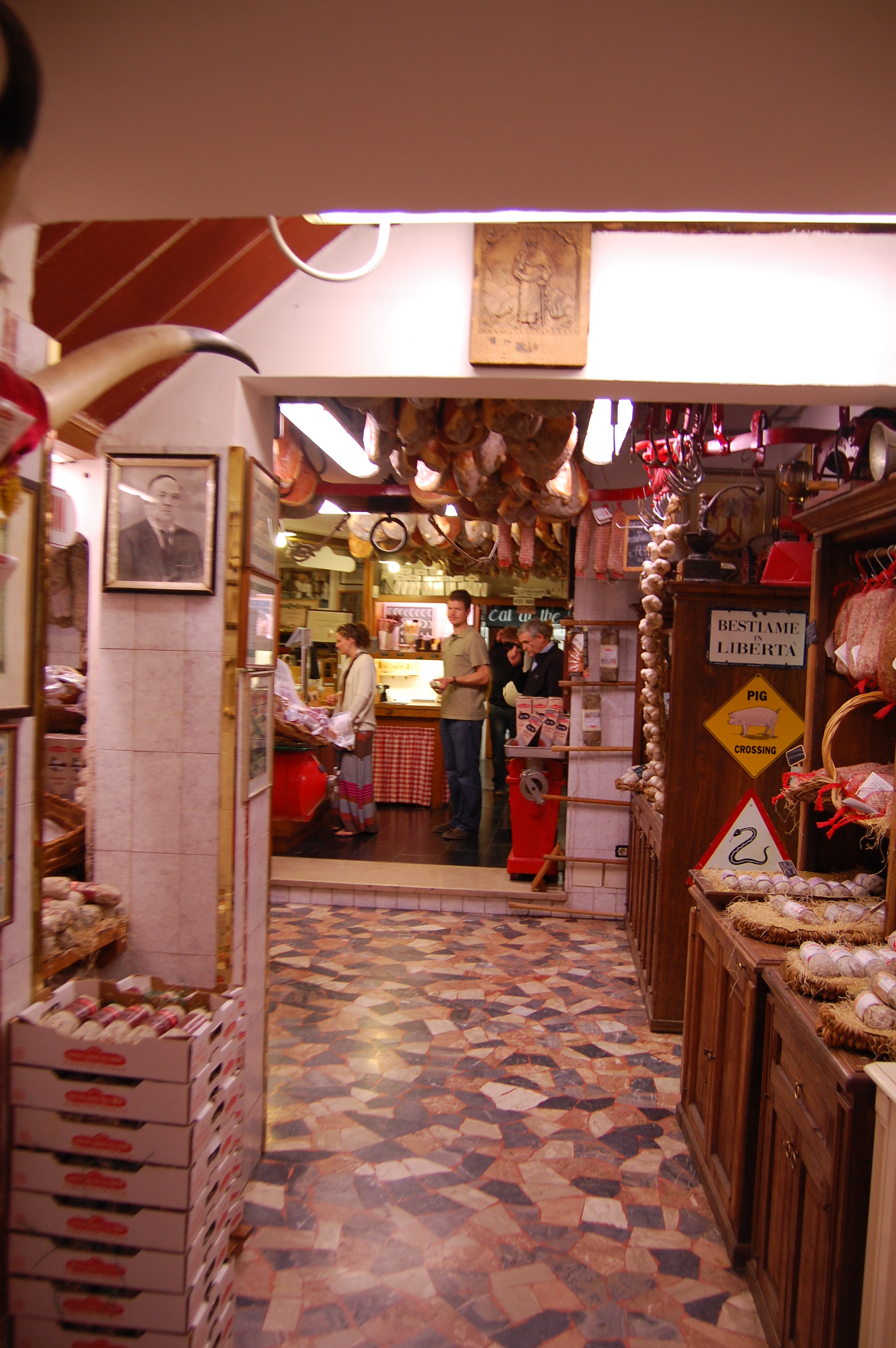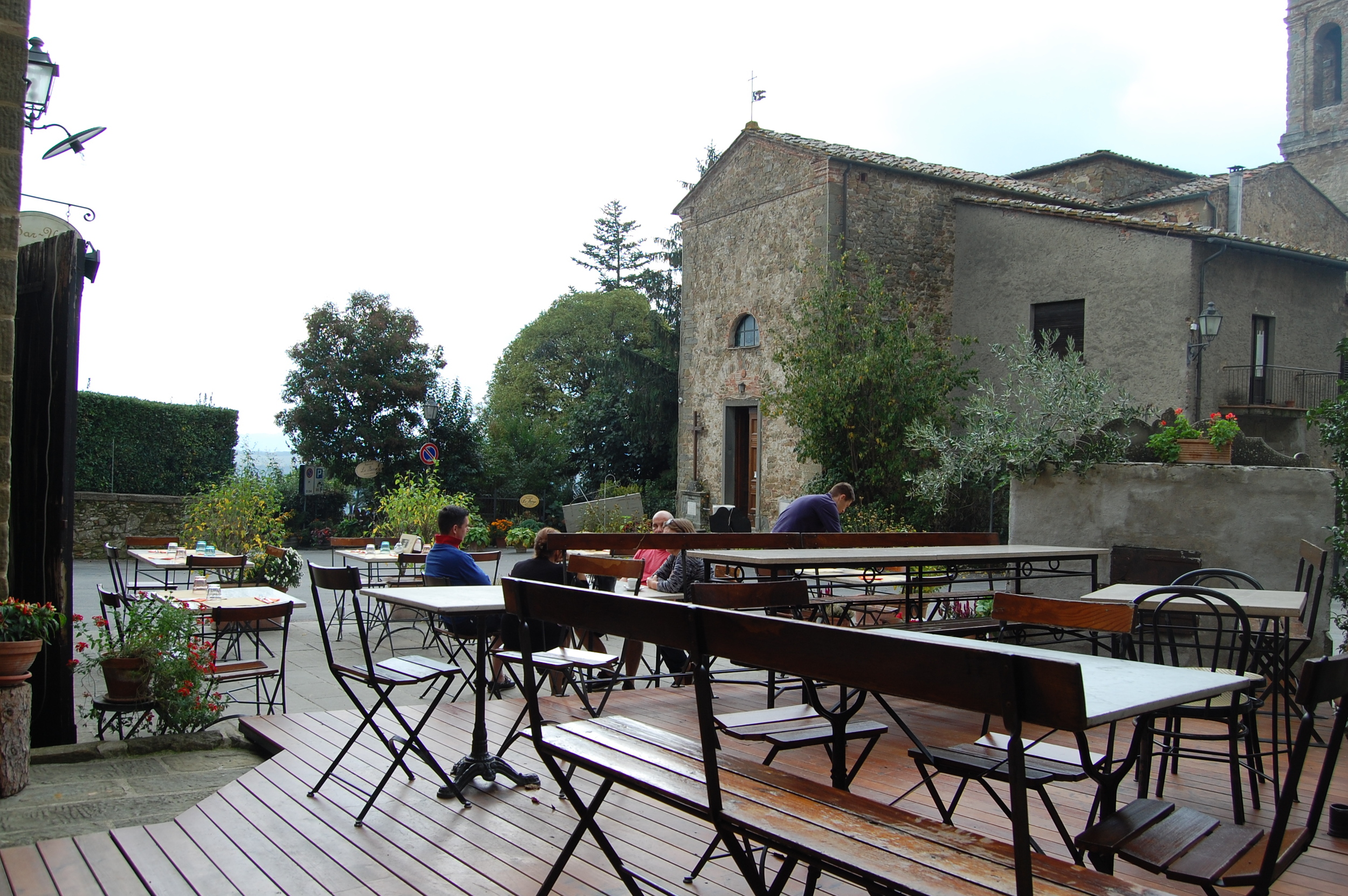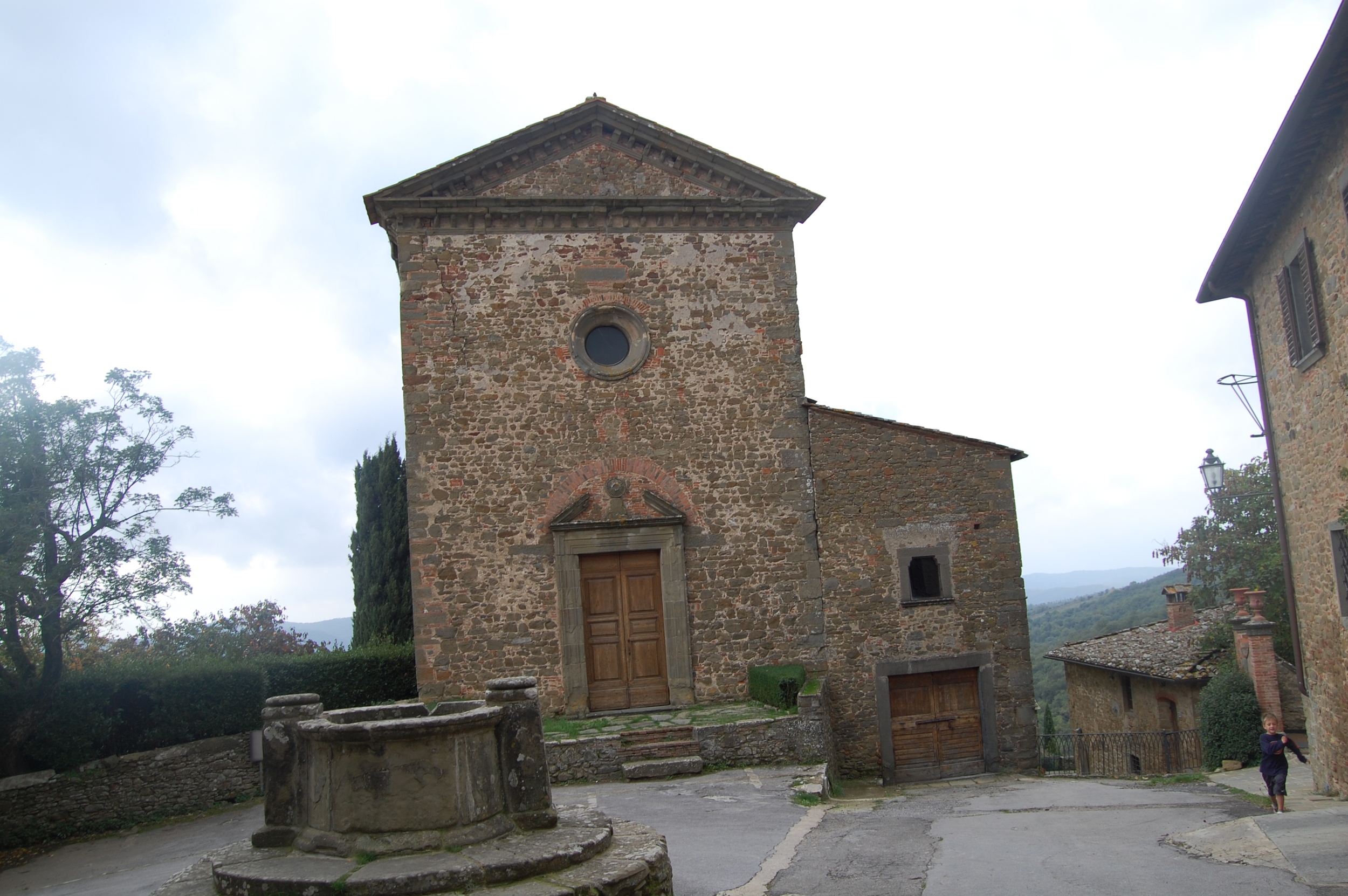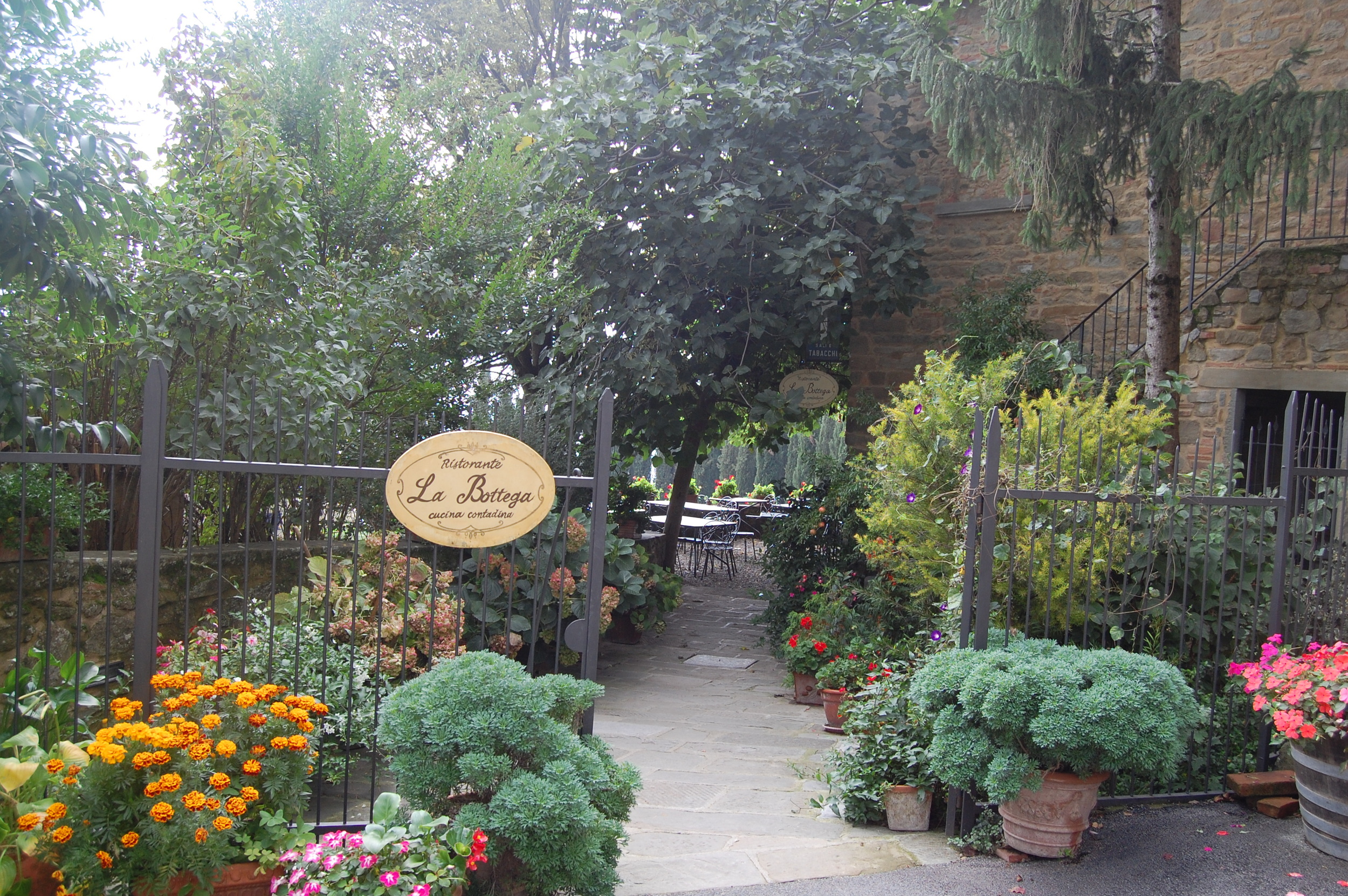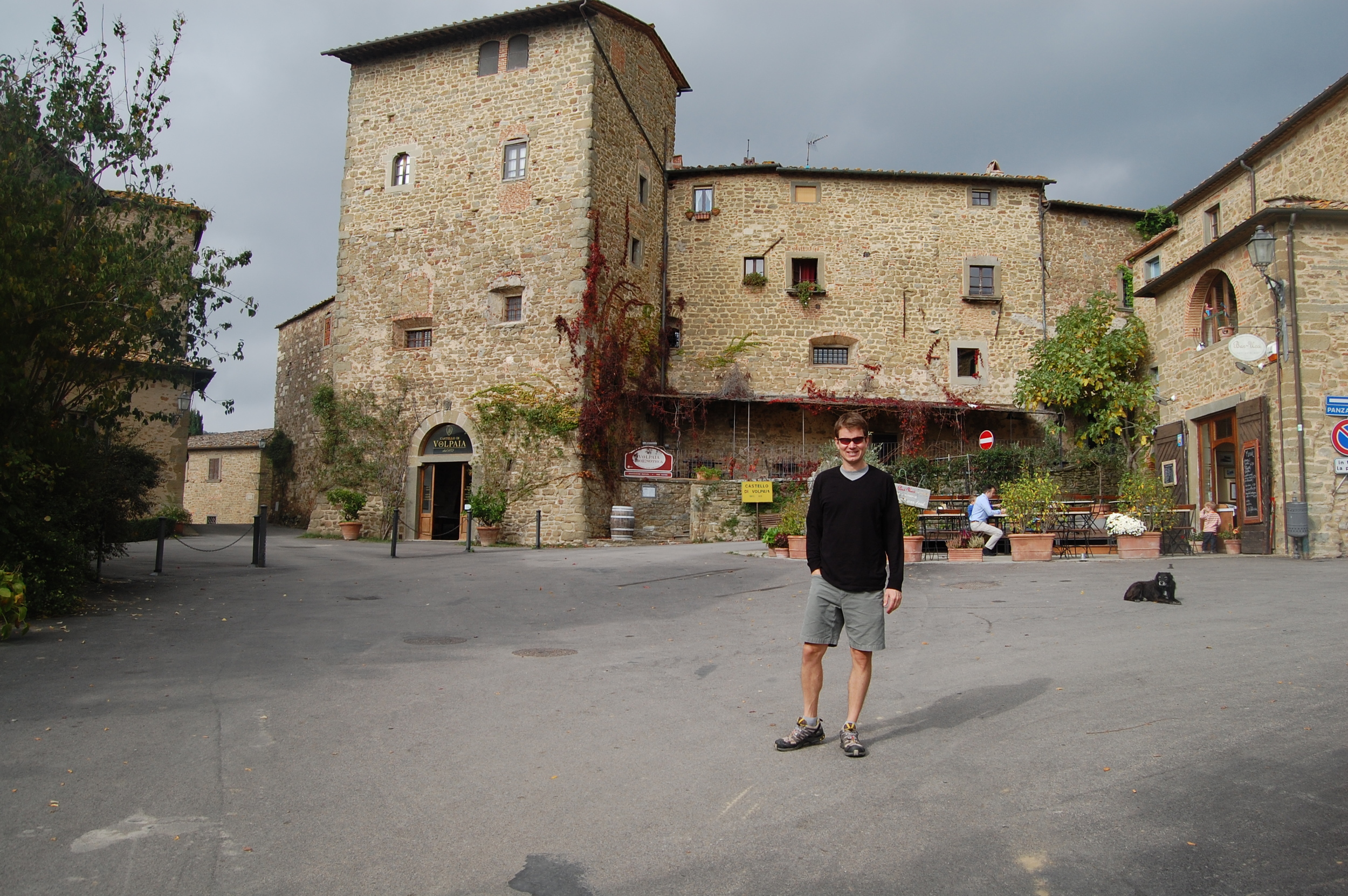In last weekend’s NY Times Travel section, there was an article about Chianti, Italy. It was one of those 36 hour travel stories. If you are contemplating a trip to Chianti (the Tuscan region between Florence and Sienna) without children, this is the article you should read. If you are contemplating a trip to Chianti with children, you should expect to do roughly half of this list in double the amount of time.
Our family travel brand is becoming one where we like to mix city and rural travel in the same trip. That combination isn’t possible without the luxury of a car or time, but when we get both – we find ourselves gravitating towards a balance of urban sightseeing and the active boy version of quiet retreat. With that in mind, we decided to stay in a redone old farmhouse in Strada in Chianti (the circle closest to Florence.) Too far to be a suburb, more like an exburb of Florence, the farmhouse was in the middle of vineyards and olive trees with enough grass to play football (Mama joined in too) and a nearby forested area teeming with wild boar hunters.
There is not much to suggest in Strada itself, save for the one recommended restaurant, the Padellina. Known for its Bistecaa alla Fiorentina, we choose it among the four restaurants in town for our inaugural Tuscan dinner. Arriving just before the dinner rush at 8pm on a Saturday night, we were turned away (rudely I might add) because we did not have reservations and they were “full” although there wasn’t yet a single patron in the restaurant. If felt spurious in the moment, but upon reflection – it was consistent with other experiences we’ve had in Europe. With value placed on unhurried dining instead of turning tables, the results are often only one to two seatings a night. I just wish he could have been less patronizing about it so as not to cause even a hairline fracture in my certainty that Italians are the continent’s most warm and friendly people.
The irritation of that miss dissipated exactly 20 minutes later when we took a seat here. Located up a steep zigzagging road from the town of Greve (also circled) is a hamlet called Montefioralle, population 100, with this small family trattoria called La Castellana. With only ten tables, a prudently placed call from the car got us a Saturday night seat for what was not only a memorable first Tuscan meal – but one of the best meals we’ve had so far in Europe. There was most definitely wild boar on the menu, and complimentary house-made grappa and limoncello to encourage us to linger long enough for our youngest to fall asleep. By night, I was dreaming of spending a month in the kitchen of La Castellana working alongside the chef matriarch and her daughter learning how to make traditional braised beef, gnocchi with wild boar ragu, taglierini with fresh truffle, and squash blossom ravoli. By morning, I was calling to make a reservation for the following night. Eating at the same place twice in a row is not our family travel brand, but there are exceptions to every rule and this was one.
Day 1: Florence
After some pointless discussion about driving or busing into Florence, we made the decision to drive the 30 minutes from Strada and park. Totally the right call. If you have a car and there are plenty of parking garages, best not to roll the die with Italian public transportation. With only one day in Florence, we decided to “plaza hop”, tour The Duomo, walk across the Ponte Vecchio and past the Uffizi, and find the best pizza in the city. I don’t know if was, but Gusta Pizza had us and crowds of other people eating out of the palms of their well-floured hands. The boys unanimously rated Rome higher than Florence, but that could have been because we were packing everything into one day or we spent a smidgen too long in the colorful but gritty outdoor market near the Church of San Lorenzo. Even children can sniff out cheap leather, clothing, and souvenirs. With a second day, we would have gone into the Uffizi … but instead we moved to the countryside.
Day 2: Spin the Bottle and pick a Winery
So there’s a lot of Chianti in Chianti. Chianti has apparently evolved a lot since the 70s where it used to have a reputation of being low quality, but nowadays with the modification of the DOP grape mix (80% sangiovese grape + rest as you like) you can find a huge range of it. There are eight Chianti regions for starters. Without any predestined organization, it turned out that we were in the classified region of Chianti Classico – the most highly regarded of the eight regions. Designated by the Black Rooster trademark, there are more farm houses/tasting rooms making/serving Chianti Classico per capita than Dunkin Donuts in Boston. Given this abundance of opportunity, you need a guiding principle. Ours was to listen to our Italian host Lucca who recommended a guided tour and tasting at Carpinento in Dudda (circled on map). Learning from the previous day’s failure, we called ahead to make a reservation and confirmed that yes, of course, children would be welcome – it’s Italy! Given the time of year, we were the only ones there and so were able to get a well-informed and generous private tour in English. The boys especially liked seeing the bottling production in process and absorbing all the stats and figures (export to 70 countries, 2.5 million bottles per year, etc.) The highlight for Brett and I was leaving with two cases of tasty wine (12 bottles) for just over 100 euros.
Dudda is tiny, but also home to a small trattoria, with the unexceptional name Casa Al Chianti. Lucca, our host who has several rental properties throughout Italy, told us that it’s the one place he eats every time he comes to Chianti because of the quality and price. Having just dropped the 100 euros on vino and seeing that Lucca had been right about everything so far, that sounded good to us. Fittingly we were served by a couple of Italian grandmothers where there were no printed menus, only a portable chalkboard (in background of photo below.)
Fueled again, we then explored the bigger town of Greve – enjoying the beautiful triangle square that was written about in the NY Times article. We also stopped in Le Cantine (also written about in the article) – perhaps the biggest wine store in Chianti. The boys were able to taste test olive oils for free as Brett and I went to look for specific Chianti we had had for dinner the night before. Had we not just come from the Carpinento tasting with boys winding down in endurance and understanding (“Didn’t you just buy wine?”), we might have stayed for the sheer enjoyment of using their automated system where you insert a card you purchase the register and press the button for the wine you want to taste. It was a lovely, if not Americanized, version of a modern tasting room. By the end of the afternoon, the boys were piled in the car while Brett and I did our best to choose a sausage from the overwhelming huge butcher shop also mentioned, Antica Macelleria Falorni. The plan was to leave the boys at home with the sausage and other antipasti while Brett and I returned to one of the many enticing looking restaurants in Greve for dinner … but that was before we got the fireplace fire going back at the barn …
Day 3: Countryside Villages
By Day 3, it was time to check out and continue our trip further south into Umbria. We had a late check in in Umbria, and so we wanted to take our time experiencing the village life of Chianti by driving along the Chiantigiana Road (SS222). I should qualify that the “we” is this scenario was Brett and I. The older boys made sure we knew exactly how much time we would save by taking the motorway. Our first village stop was Panzano (circled). This is what the 36 hours writer had to say about Panzano:
“A hilltop village may be an unlikely location for stylish fashion, but at the leather-specialty shop Verso x Verso, in the small town of Panzano in Chianti, that’s exactly what you’ll find. Even more surprising is that all the beautiful clothing and accessories on display can be made to order. So would you prefer a rounded or square toe on that handmade pair of caramel-hued oxfords? Or would you like to be fitted for a bespoke jacket — the double-zippered style in orange goat suede is gorgeous — by the Florentine-trained designer herself? After placing your order, stroll down the cobblestone alleys of this medieval village and indulge in the sunset views. Remain in Panzano to partake in the evening’s carnivorous feast at Officina della Bistecca, a restaurant owned by the eighth-generation butcher Dario Cecchini…”
There was no strolling down the cobblestone alleys of this medieval village. In fact, we didn’t end up getting out of the car in Panzano. Someone (I don’t even remember who now) was in a mood and at 10 am it wasn’t exactly prime time to see a butcher. As a substitute, we took this moment to clarify with everyone that a) yes, we would be getting out the car at the next village, b) we would all have good attitudes about it and c) no one would mention the motorway again.
By the time we got to Volpaia, everyone was on board with the reiterated plan allowing us to relish this unspoilt village -- now used exclusively as a wine estate. Evidence of the wine production is in all the ancient houses, deconsecrated churches and all the village inhabitants are directly involved in the winery, osteria or lovely café where we stopped for an espresso and piece of coffee cake. It felt like something out of a movie. We learned that they have guest houses nearby, host weddings and offer cooking schools (which I bet are fabulous given the surroundings.) We wandered in and out of the cobblestone streets, making up for missed time in Panzano, spotting vines of the berries we had just enjoyed in our pastry treats and forgetting that we had any place to be. Brett declared it his favorite Italian hillside village thus far in our travels ...
Next stop was only 7 kilometers away in Radda in Chianti, another hub of Chianti tourism. We bypassed Castellina in Chianti ( a stop in the 36 hour writer’s visit) in favor of Radda, a smaller but more charming (and probably more touristed in high season) version of Greve. While we only had another yummy lunch (it’s hard to miss with fresh pastas) and a quick walk through in Radda, we decided that if we were to come back to Chianti we would lean towards staying in this area. Without the need to do Florence, Chianti gets more and more appealing the further south you go and Radda is a good hub from which to visit Volpaia again, Siena (a place we didn’t get to on this trip) and would also be more convenient to Montalciono and Montepulciano for a full Italian wine experience. By midafternoon, it was finally time to high tail to the motorway for Part 2 of our fall trip to Italy ... but that is for another post. Now I need a lie down and perhaps ... a small glass of Chianti Classico.

